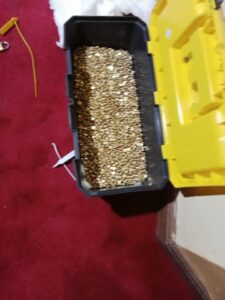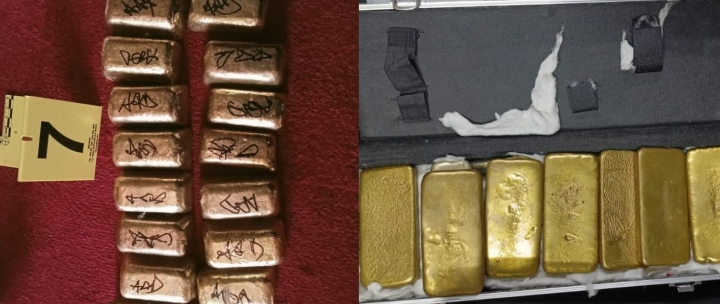Editor’s note: Getty Soila investigates Nairobi’s fake gold cartels.
In the gleaming offices of Nairobi, the promise of gold gleams like a mirage. Foreign investors arrive with high hopes: promises of 250 kg consignments, private-jet shipments, and official export contracts.
Weeks later they receive nothing but fake bars, worthless alloys, and empty assurances. Welcome to Kenya’s booming fake-gold trade.
How the scam is planned and executed
The blueprint is elegant in its simplicity, ruthless in its execution. A typical case: in one recent scheme a Canadian investor was lured into a deal for 250 kg of gold to be shipped to Dubai, for which he wired USD 318,400 (KSh 41 million) to a law firm account and then USDT 300,000 (KSh 38 million) into a crypto wallet. No gold ever arrived.
Investigators from the Directorate of Criminal Investigations (DCI) discovered that the “gold” he purchased was a cocktail of copper, zinc and tin – place-filler metals, painted gold, made to deceive.
Step-by-step:
– A seductive offer is made: access to untapped gold reserves in the region, “export ready”.
– Fake documents are produced: pro forma invoices, logistics companies, company registrations, even smelting machines and “mining certificates”.
– The investor is taken to high-end Nairobi offices (sometimes hotel boardrooms), shown “test” bars and certificates, and encouraged to move quickly.
– Money is sent via bank, escrow account, or sometimes via crypto.
–Delivery fails. When questions are asked, new fees are demanded (clearance, tax, customs, smelting). Then the trail vanishes.
– The fraudsters may melt down the fake bars, reuse materials, and shift operations. Arrests occur, but many victims never recover funds.
– This is not petty fraud. One operation involved more than 1,080 kg of supposed gold.
–Another involved a smelting machine and fake gold bars recovered in a raid on a Spring Valley residence in high-end Nairobi.

Why is Kenya a bastion of the fake gold trade?
Why is Kenya, and especially Nairobi, emerging as a hub? Several factors converge:
1. Geographic & regulatory exposure
Kenya is situated in East Africa, a region rich in mineral trade yet blighted by porous oversight. Fraudsters exploit weak regulatory frameworks, opaque chains of custody for gold and weak enforcement. A recent DCI publication states Nairobi is “at the centre of the global gold racketeering rings”.
2. Local culture of credibility
Fraudsters leverage Kenya’s reputation as an entrepreneurial hub. They use polished offices, expensive cars, suits, flashy meeting rooms, and hotel boardrooms. Their grooming, patience, and smooth talk build trust.
The veneer of legitimacy is strong; Kenyans are seen as savvy, patient negotiators, and that’s exploited. Victims recall being shown “sample bars” and official-looking credentials. For many victims from abroad, Kenya appears as a credible stepping-stone to African gold.
3. Money-laundering & scam-culture environment. Kenya has been identified in multiple studies as a destination for laundering and scamming operations. The same banking corridors, forex bureaux, and shell companies that facilitate one type of fraud also serve fake-gold operations. The Global Initiative report on gold smuggling highlights Kenya’s role as a regional hub.
4. Foreign investor vulnerability
Many victims are foreigners: Canadians, Gabonese, and Pakistani nationals. They arrive believing they are entering a legitimate export deal; they may not fully understand Kenya’s mining & export regulatory regime. This asymmetry is exploited. Example: a Pakistani national lost KSh 4.5 million after being sold 500 g of fake gold.
The Judiciary & institutional gaps
A critical question: does Kenya’s judiciary play a role, complicit or complicit by omission? Several red flags:
–Cases drag on for months or years; suspects obtain bail quickly. E.g., in one scam involving USD 120,000 (KSh 15 million), two businessmen from Romania and Switzerland waited long for justice.
– The tools to convict – forensic testing of gold, tracking of crypto payments – are still weak.
– Some accused are lawyers or have legal credentials themselves: for example, a Nairobi advocate was arrested for facilitating a fake gold deal.
–Political exposure: In earlier years high-level allegations tied to fake gold (“friends of politicians”) surfaced.
– Enforcement agencies occasionally recover smelting machines, forged documents, and fake bars. But the ultimate asset recovery for victims remains limited.
Thus, the judiciary may not be actively complicit in terms of direct decision-making, but the system’s inertia, slow movement of cases, and the ability of fraudsters to leverage legal fronts create fertile ground for scams.
Do victims get justice?
The short answer: rarely. Investigations by DCI are increasing. There are numerous arrests, but convictions, asset recovery, and victim restitution are still the exception.
– Victims report being told to pay “extra fees” after the initial payment; then funds vanish.
– Some suspects are arraigned, but bail is granted, causing delays in trials.
– Few foreign investors successfully trace their funds or receive them back.
– The pervasive use of crypto adds complexity, making tracking harder. In one case the complainant sent USDT to a wallet.
Victims are left with an empty safe, false promises and endless court mentions. Their trust is traded for blank paperwork and melted alloys.
Conclusion: a mirage that explodes
In Kenya’s gold-fraud world the façade is well-constructed. Shiny bars, private-jet shipments, high-rate deals.
Underneath: a tapestry of forged company certificates, smelting machines, shell firms, airport hotel meetings and crypto wallets.
Kenya sits at this confluence because it offers the right mix of local entrepreneurship-style presentation, loopholes in regulation, access to regional trade flows, and foreign investor vulnerability.
READ ALSO: Justin Muturi: Day Ruto Got Angry after I Refused to Sign the KSh 129 Billion Corrupt Deal
The moral is stark: when gold is promised in the shade of a palm-lined Nairobi meeting room, show the chain of custody. Demand an independent assay of bars.
Verify company registrations. Resist the urgency. Because behind the shine may only be painted zinc.
PAY ATTENTION: Reach us at info@gotta.news.






















